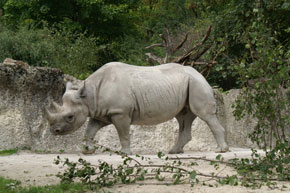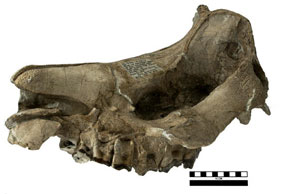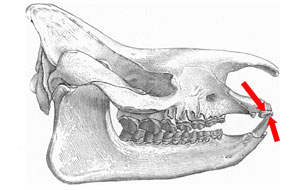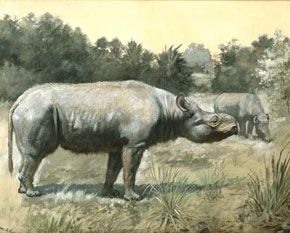Rhinocerotidae
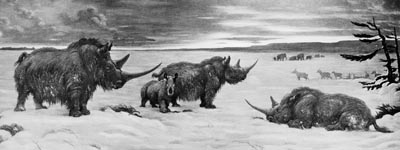 Pictured left: Reconstruction of woolly rhinos (Coelodonta antiquitatis) by artist Charles Knight. AMNH Library Special Collections Neg No. 37227
Pictured left: Reconstruction of woolly rhinos (Coelodonta antiquitatis) by artist Charles Knight. AMNH Library Special Collections Neg No. 37227
Rhinocerotidae: True rhinos are members of the family Rhinocerotidae. Compared to other perissodactyl families, true rhinos got off to a late start and do not appear in the fossil record until about 40 million years ago; most of the other perissodactyl families appear 55.5-46 million years ago. We think of rhinos as being characterized by a nasal horn, but in fact most members of the group are hornless. True rhinos are united by having large, tusk-like lower incisor teeth that sharpen on smaller chisel-shaped upper incisors. Curiously, the living African rhinos have lost their incisors, although they have many other anatomical features that indicate they are closely related to other true rhinos.
The specialized incisors can be seen on the skull of Menoceras, a small North American rhino from the early Miocene. While many rhinos lack horns, nasal horns did evolve several times within this family. Menoceras evolved a pair of nasal horns that are situated side-by-side, rather than front-to-back as in living African rhinos. Horns were only present on males of Menoceras; in living rhinos that have horns, they are present in both sexes.
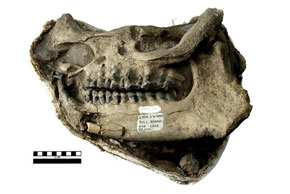
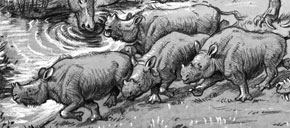
Left: Skull of the early Miocene rhinoceros Menoceras (AMNH 112246) from Platte County, Wyoming. Victoria Healy/AMNH. Right: Reconstruction of a herd of the Miocene rhino Menoceras, from an unpublished 1917 sketch of the Miocene fauna Agate Springs Nebraska by AMNH artist Erwin Christman. AMNH Library Special Collections Neg No. 36900.
Teleoceras is a common rhino in the Miocene of North America and was the last to survive on this continent, finally dying out at the end of the Miocene. It had very short limbs, a long torso, a short nasal horn, and high-crowned teeth. Its remains are commonly found in huge numbers buried together in lakes, ponds, and river deposits. Study of these large accumulations of bones suggests that populations were female-dominated. Males commonly died at younger ages and suffered from very high mortality rates due competition for females which may have involved frequent horn- and tusk-inflicted wounds. This behavioral pattern resembles living rhinos, and is an instance where the fossil record reveals aspects of the social behaviors of an extinct species.
The five modern species of rhinos live in southeast Asia and Africa, and range in habitat from dense tropical rainforest to dry dessert scrub. Some fossil rhinos, such as the woolly rhino (Coelodonta) of the ice age of Europe were cold-adapted. They had a broad, flattened horn that was used for scraping snow to get at vegetation below, and cave paintings show that they also had a long fur coat similar to that of woolly mammoths.
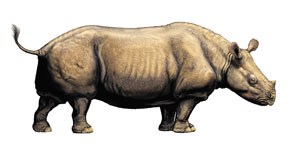
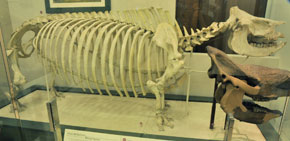
Left: Reconstruction of the Miocene rhinoceros Teleoceras. Carl Buell. Right: Skeleton of the extinct rhinoceros Teleoceras from the Miocene of North America. Michael Holmes\AMNH.

